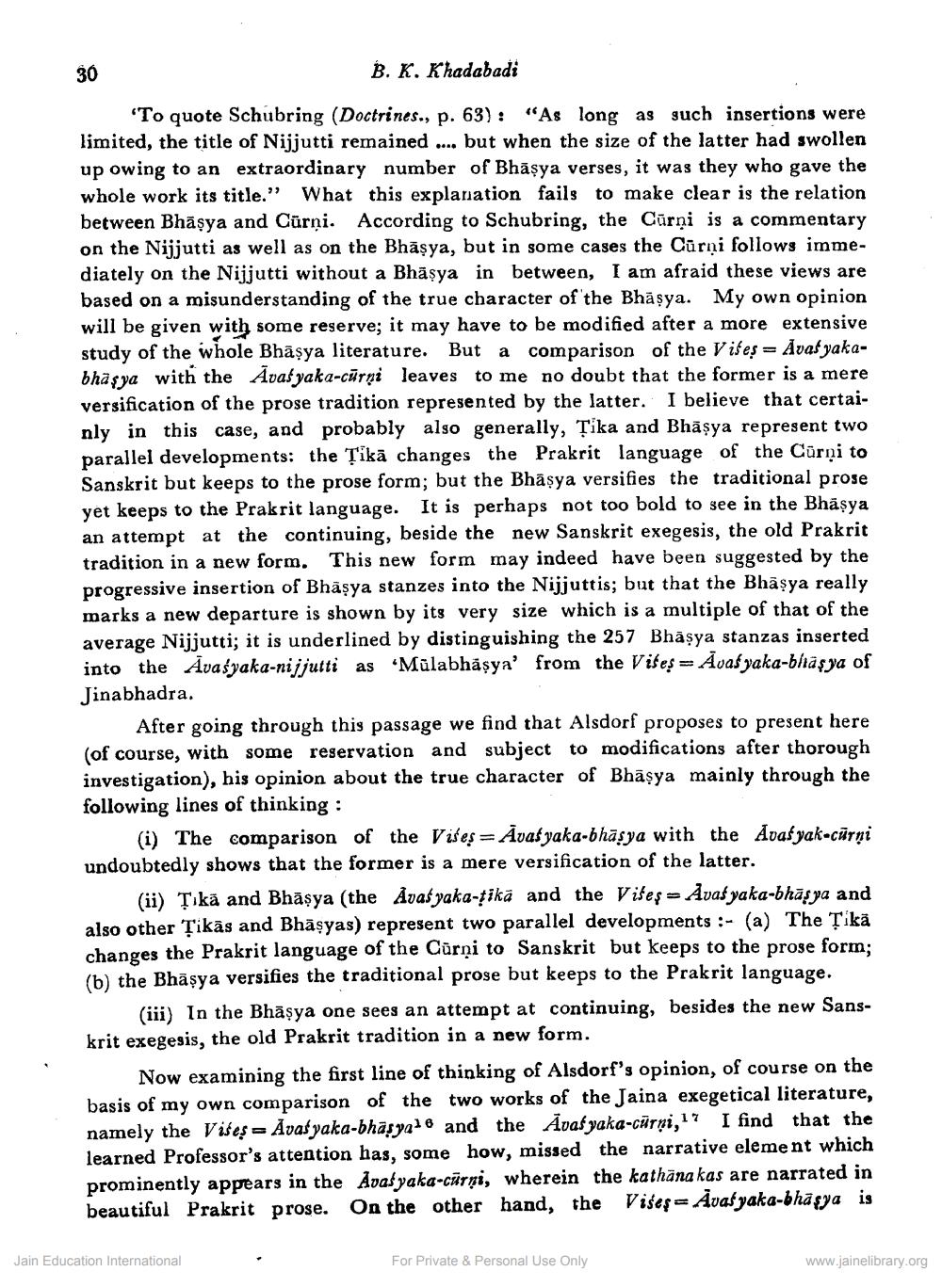Book Title: Reflections on the Jaina Exgetical Literature Author(s): B K Khadabadi Publisher: Z_Aspect_of_Jainology_Part_3_Pundit_Dalsukh_Malvaniya_012017.pdf View full book textPage 4
________________ B. K. Khadabadi "To quote Schubring (Doctrines., p. 63): "As long as such insertions were limited, the title of Nijjutti remained... but when the size of the latter had swollen up owing to an extraordinary number of Bhasya verses, it was they who gave the whole work its title." What this explanation fails to make clear is the relation between Bhāṣya and Carni. According to Schubring, the Carni is a commentary on the Nijjutti as well as on the Bhāṣya, but in some cases the Carai follows immediately on the Nijjutti without a Bhasya in between, I am afraid these views are based on a misunderstanding of the true character of the Bhasya. My own opinion will be given with some reserve; it may have to be modified after a more extensive study of the whole Bhasya literature. But a comparison of the Vifes Avasyakabhagya with the Avalyaka-curgi leaves to me no doubt that the former is a mere versification of the prose tradition represented by the latter. I believe that certainly in this case, and probably also generally, Tika and Bhāṣya represent two parallel developments: the Tika changes the Prakrit language of the Cūrṇi to Sanskrit but keeps to the prose form; but the Bhasya versifies the traditional prose yet keeps to the Prakrit language. It is perhaps not too bold to see in the Bhasya an attempt at the continuing, beside the new Sanskrit exegesis, the old Prakrit tradition in a new form. This new form may indeed have been suggested by the progressive insertion of Bhasya stanzes into the Nijjuttis; but that the Bhasya really marks a new departure is shown by its very size which is a multiple of that of the average Nijjutti; it is underlined by distinguishing the 257 Bhasya stanzas inserted into the Avafyaka-nijjutti as Mülabhäşya' from the Vifes Avafyaka-bhagya of Jinabhadra. 30 After going through this passage we find that Alsdorf proposes to present here (of course, with some reservation and subject to modifications after thorough investigation), his opinion about the true character of Bhasya mainly through the following lines of thinking: (i) The comparison of the Vites = Avatyaka-bhagya with the Avafyak-cürgi undoubtedly shows that the former is a mere versification of the latter. (ii) Tika and Bhasya (the Avafyaka-tika and the Vifes Avafyaka-bhāya and also other Tikas and Bhasyas) represent two parallel developments: (a) The Tika changes the Prakrit language of the Carni to Sanskrit but keeps to the prose form; (b) the Bhasya versifies the traditional prose but keeps to the Prakrit language. (iii) In the Bhāṣya one sees an attempt at continuing, besides the new Sanskrit exegesis, the old Prakrit tradition in a new form. Now examining the first line of thinking of Alsdorf's opinion, of course on the basis of my own comparison of the two works of the Jaina exegetical literature, namely the Vises Avasyaka-bharyale and the Avafyaka-cürṇi,17 I find that the learned Professor's attention has, some how, missed the narrative element which prominently appears in the Avalyaka-cürgi, wherein the kathana kas are narrated in beautiful Prakrit prose. On the other hand, the On the other hand, the Vises-Avafyaka-bhagya is Jain Education International For Private & Personal Use Only www.jainelibrary.orgPage Navigation
1 2 3 4 5 6 7
